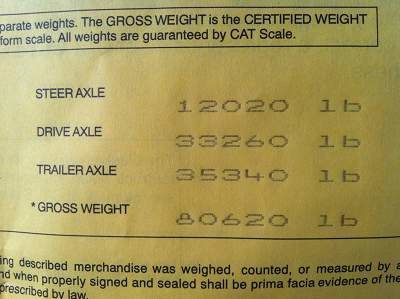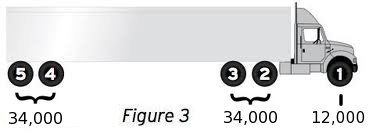Review Questions - Click On The Picture To Begin...

- The position of the trailer's tandems
- The amount of fuel onboard and the placement of the fuel tanks
- All of these factors affect the weight distribution across the axles
- The position of the tractor's 5th wheel
Quote From The CDL Manual:
The primary factors which will affect the weight distribution across a truck's axles are:
- The position of the trailer's tandems
- The position of the tractor's 5th wheel
- The overall weight of the cargo in the trailer and the horizontal (front-to-back) position of its center of gravity
- The amount of fuel onboard and the placement of the fuel tanks
- Adding more fuel to the tanks
- Sliding the trailer tandems
- Moving the cargo toward the rear of the trailer
- Sliding the tractor 5th wheel
Quote From The CDL Manual:
The final key point to understand when it comes to weight transfer is that none of the methods of redistributing weight between the different sets of axles, including sliding your 5th wheel, sliding your tandems, or moving the cargo around will have any affect on your gross weight.
The only way to affect the gross vehicle weight would be to add or remove weight from the vehicle. Adding or burning off fuel, or adding or removing cargo would be two examples of ways to alter the gross vehicle weight.
- 13,000 pounds in Illinois
13,000 pounds in Indiana - 20,000 pounds in Illinois
13,000 pounds in Indiana - 13,000 pounds in Illinois
12,000 pounds in Indiana - 20,000 pounds in Illinois
12,000 pounds in Indiana
Quote From The CDL Manual:
TruckingTruth's Advice:
We have to find the most restrictive law for each state.
Illinois
Allows 20,000 pounds on the steer axle
Your tire load rating of 6,500 means your maximum legal weight is 13,000 pounds on the steer axle.
The 13,000 pounds is the most restrictive for Illinois
Indiana
Indiana allows 12,000 on the steer axle
Your tire load rating of 6,500 means your maximum legal weight is 13,000 pounds on the steer axle.
The 12,000 pound limit imposed by Indiana on the steer axle is the most restrictive for Indiana
- 12,300 pounds
- 15,500 pounds
- 12,000 pounds
- 20,000 pounds
Quote From The CDL Manual:
TruckingTruth's Advice:
You must find the most restrictive law to determine your maximum legal weight.
The maximum Oregon allows is 20,000 pounds on the steer axle
The load rating on your tires is 6,150, which would put your maximum legal weight at 12,300 pounds regardless of the fact that there are less restrictive laws.
The maximum Oregon allows by weight is 600 pounds per inch. You have 10 inch tires so that would be a maximum of 6000 pounds per tire, or 12,000 pounds on the steer axle, which is the most restrictive of the various laws. Therefore, 12,000 pounds is your legal limit in this truck in Oregon.
- The position of the trailer's tandems
- None of these affect the gross vehicle weight at all
- Moving the cargo toward the front or rear of the trailer
- The position of the tractor's 5th wheel
Quote From The CDL Manual:
TruckingTruth's Advice:
- 20,000 pounds
- 12,000 pounds
- 34,000 pounds
- 26,000 pounds
Quote From The CDL Manual:
The legal weight limits for each set of axles is:
- Steer axle varies by state
- 34,000 for the drive axles
- 34,000 for the trailer tandems
- 14,000 pounds
- 20,000 pounds
- None of these are correct
- 12,000 pounds
Quote From The CDL Manual:
TruckingTruth's Advice:
We have to find the most restrictive law to determine our maximum weight.
California allows up to 20,000 pounds on the steer axle
There is no requirement based upon tread width in California, so the width of your steer tires is irrelevant for this example
Your steer tires have a maximum load rating of 7,000 pounds each, which would therefore limit your legal steer axle weight to 14,000 pounds. This is the most restrictive of the laws, so 14,000 pounds is your legal weight limit in this case.









 TT On Facebook
TT On Facebook